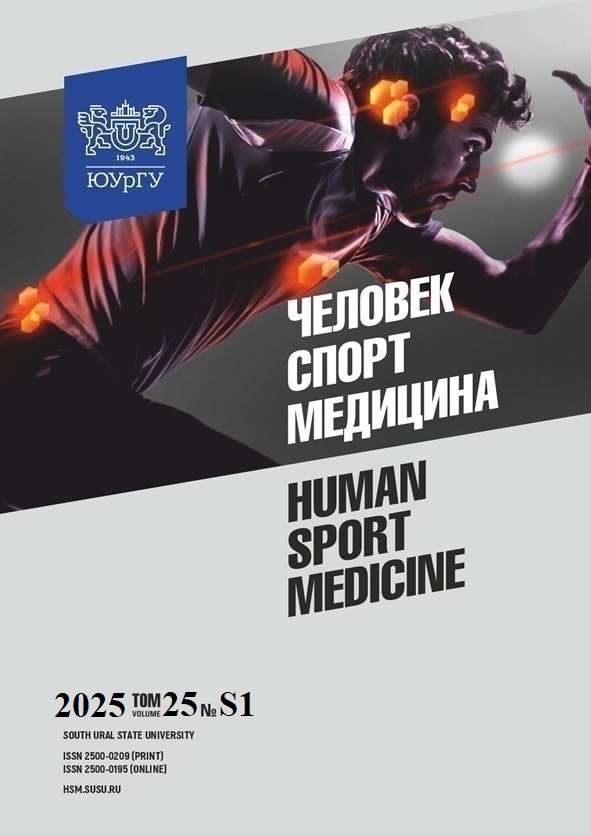ОПТИМИЗАЦИЯ ФИЗИЧЕСКОЙ АКТИВНОСТИ КАК СРЕДСТВО ПОВЫШЕНИЯ ФУНКЦИОНАЛЬНОЙ ПОДГОТОВЛЕННОСТИ ЖЕНЩИН ВТОРОГО ЗРЕЛОГО ВОЗРАСТА В ПОСТМЕНОПАУЗЕ
Аннотация
Цель: изучение влияния комплексной программы: повышения физической активности на аэробные и анаэробные показатели, а также постуральный контроль у офисных работников. Материалы и методы. Участниками исследования стали 42 женщины в возрасте 51 ± 5 лет. Программа повышения физической активности включала физкультурно-оздоровительные занятия в группах три раза в неделю в течение восьми месяцев, содержание которых составили силовые тренировки, тренировки на улучшение равновесия и мобильности суставов, кардиотренировки, специфические упражнения для обеспечения женского здоровья и укрепления мышц тазового дна. Занятия в группах дополнялись участием женщин во всероссийской программе по фоновой ходьбе «Человек идущий», самостоятельном выполнении утренней зарядки, содержание которых определялось научной группой. Оценка аэробной и анаэробной мощности проводилась с использованием велоэргометров Monark 891 и eBike и системы газоанализа Metalizer 3B, а для оценки постурального контроля применялась система стабилографии Стабилан 01–2. Результаты. Результаты показали, что участие женщин второго зрелого возраста в комплексной программе повышения физической активности обеспечило статистически значимое снижение систолического на 2,5 % и диастолического артериального давления на 3,8 % в состоянии покоя, а также улучшение аэробной производительности и постурального контроля на 3,9 %. Участницы продемонстрировали увеличение пикового потребления кислорода на 22 % и улучшение балансовых показателей, включая качество функции равновесия. Подтверждено, что регулярные физические тренировки не только замедляют негативные изменения, связанные с возрастом, но и способствуют улучшению общего состояния здоровья. Заключение. Регулярная физическая активность способствует повышению аэробной и анаэробной работоспособности, а также улучшает постуральный контроль.
Литература
2. Мавлиев Ф.А., Зотова Ф.Р., Иванова Е.С., Гончаренко Д.И. Реакции хронотропной и инотропной функций сердца на плавновозрастающую физическую нагрузку у женщин 45–60 лет // Рос. кардиол. журнал. 2024. Т. 29, № S6. С. 30. [Mavliev F.A., Zotova F.R., Ivanova E.S., Goncharenko D.I. [Reactions of Chronotropic and Inotropic Functions of the Heart to Smoothly Increasing Physical Activity in Women Aged 45–60 Years]. Rossiyskiy kardiologicheskiy zhurnal [Russian Journal of Cardiology], 2024, vol. 29, no. S6, p. 30. (in Russ.)]
3. Slade J.M., Miszko T.A., Laity J.H. et al. Anaerobic Power and Physical Function in Strength-trained and Non-strength-trained Older Adults. The Journals of Gerontology Series A: Biological Sciences and Medical Sciences, 2002, vol. 57, no. 3, pp. 168–172. DOI: 10.1093/gerona/57.3.M168
4. Brooke-Wavell K., Athersmith L.E., Jones P.R.M., Masud T. Brisk Walking and Postural Stability: a Cross-sectional Study in Postmenopausal Women. Gerontology, 1998, vol. 44, no. 5, pp. 288–292. DOI: 10.1159/000022028
5. Leitão L., Marocolo M., Souza H.L.D. et al. Can Exercise Help Regulate Blood Pressure and Improve Functional Capacity of Older Women with Hypertension Against the Deleterious Effects of Physical Inactivity? International Journal of Environmental Research and Public Health, 2021, vol. 18, no. 17. DOI: 10.3390/ijerph18179117
6. Carapeto P.V., Aguayo-Mazzucato C. Effects of Exercise on Cellular and Tissue Aging. Aging (Albany NY), 2021, vol. 13, no. 10, pp. 14522–14543. DOI: 10.18632/aging.203051
7. Wanderley F.A.C., Oliveira J., Mota J., Carvalho J. Effects of a Moderate-intensity Walking Program on Blood Pressure, Body Composition and Functional Fitness in Older Women: Results of a Pilot Study. Archives of Exercise in Health and Disease, 2010, vol. 1, no. 2, pp. 50–57. DOI: 10.5628/aehd.v1i2.87
8. Motlani V., Motlani G., Pamnani S. et al. Endocrine Changes in Postmenopausal Women: a Comprehensive. Cureus, 2023, vol. 15, no. 12. DOI: 10.7759/cureus.51287
9. Fenton A., Smart C., Goldschmidt L. et al. Fat Mass, Weight and Body Shape Changes at Menopause–causes and Consequences: A Narrative Review. Climacteric, 2023, vol. 26, no. 4, pp. 381–387. DOI: 10.1080/13697137.2023.2178892
10. Hill D.W., Smith J.C. Gender Difference in Anaerobic Capacity: Role of Aerobic Contribution. British Journal of Sports Medicine, 1993, vol. 27, no. 1, pp. 45–48. DOI: 10.1136/bjsm.27.1.45
11. Imogie A.O. Sustenance of Women's Health After the Age of 45 Years at the University of Benin, Benin City, Nigeria. Health Care for Women International, 2000, vol. 21, no. 8, pp. 717–726. DOI: 10.1080/073993300300340538
12. dos Anjos Souza V.R., Vivan L., Seffrin A. et al. Impact of Aging on Maximal Oxygen Uptake in Female Runners and Sedentary Controls. Experimental Gerontology, 2024, vol. 193. DOI: 10.1016/j.exger.2024.112476
13. Jaworski J., Kolodziej E. Assessment of Postural Stability Using the Zebris Platform in Women Above the Age of 60. Journal of Kinesiology and Exercise Sciences, 2020, vol. 30, no. 92, pp. 13–18. DOI: 10.5604/01.3001.0014.8210
14. Kelley G.A., Kelley K.S. Aerobic Exercise and Resting Blood Pressure in Women: a Meta-analytic Review of Controlled Clinical Trials. Journal of Women's Health & Gender-based Medicine, 1999, vol. 8, no. 6, pp. 787–803. DOI: 10.1089/152460999319110
15. Low Choy N., Brauer S.G., Nitz J.C. Changes in Postural Stability in Women Aged 20 to 80 Years. The Journals of Gerontology. Series A, Biological Sciences and Medical Sciences, 2003, vol. 58, no. 6, pp. 525–530. DOI: 10.1093/gerona/58.6.M525
16. Low Choy N., Brauer S.G., Nitz J.C. Linking Stability to Demographics, Strength and Sensory System Function in Women Over 40 to Support Preemptive Preventive Intervention. Climacteric, 2008, vol. 11, no. 2, pp. 144–154. DOI: 10.1080/13697130801931821
17. Naude C.E., Brand A., Schoonees A. et al. Low-carbohydrate Versus Balanced-carbohydrate Diets for Reducing Weight and Cardiovascular Risk. Cochrane Database Syst Rev, 2022, vol. 28, no. 1. DOI: 10.1002/14651858.CD013334
18. El Khoudary S.R., Aggarwal B., Beckie T.M. et al. Menopause Transition and Cardiovascular Disease Risk: Implications for Timing of Early Prevention: a Scientific Statement from the American Heart Association. Circulation, 2020, vol. 142, no. 25, pp. 506–532. DOI: 10.1161/CIR.0000000000000912
19. Nappi R.E., Simoncini T. Menopause Transition: a Golden Age to Prevent Cardiovascular Disease. The Lancet Diabetes & Endocrinology, 2021, vol. 9, no. 3, pp. 135–137. DOI: 10.1016/S2213-8587(21)00018-8
20. Pinto E. Blood Pressure and Ageing. Postgraduate Medical Journal, 2007, vol. 83, no. 976, pp. 109–114. DOI: 10.1136/pgmj.2006.048371
21. Puszczalowska-Lizis E., Bujas P., Omorczyk J. Postural Stability in Women in the Eighth and Ninth Decades of Life. Acta of Bioengineering and Biomechanics, 2016, vol. 18, no. 3, pp. 115–121.
22. Reaven P.D., Barrett-Connor E., Edelstein S. Relation between Leisure-time Physical Activity and Blood Pressure in Older Women. Circulation, 1991, vol. 83, no. 2, pp. 559–565. DOI: 10.1161/ 01.CIR.83.2.559
23. Edvardsen E., Hansen B.H., Holme I.M. et al. Reference Values for Cardiorespiratory Response and Fitness on the Treadmill in a 20-to 85-year-old Population. Chest, 2013, vol. 144, no. 1, pp. 241–248. DOI: 10.1378/chest.12-1458
24. Staffileno B.A., Braun L.T., Rosenson R.S. The Accumulative Effects of Physical Activity in Hypertensive Post-menopausal Women. European Journal of Cardiovascular Prevention & Rehabilitation, 2001, vol. 8, no. 5, pp. 283–290. DOI: 10.1177/174182670100800507
25. Safar M.E., Lange C., Tichet J. et al. The Data from an Epidemiologic Study on the Insulin Resistance Syndrome Study: the Change and the Rate of Change of the Age–blood Pressure Relationship. Journal of Hypertension, 2008, vol. 26, no. 10, pp. 1903–1911. DOI: 10.1097/HJH.0b013e32830b8937
References
1. Зотова Ф.Р., Мавлиев Ф.А., Иванова Е.С., Гончаренко Д.И., Хрущева Р.Ш. Потенциал физической активности в обеспечении трудового долголетия женщин 45–60 лет // Наука и спорт: современные тенденции. 2023. Т. 11, № 3. С. 135–143. [Zotova F.R., Mavliev F.A., Ivanova E.S. et al. [Potential of Physical Activity in Ensuring Working Longevity of Women Aged 45–60 Years]. Nauka i sport: soveremnnye tendencii [Science and Sport. Current Trends], 2023, vol. 11, no. 3, pp. 135–143. (in Russ.)] DOI: 10.36028/2308-8826-2023-11-3-135-1432. Мавлиев Ф.А., Зотова Ф.Р., Иванова Е.С., Гончаренко Д.И. Реакции хронотропной и инотропной функций сердца на плавновозрастающую физическую нагрузку у женщин 45–60 лет // Рос. кардиол. журнал. 2024. Т. 29, № S6. С. 30. [Mavliev F.A., Zotova F.R., Ivanova E.S., Goncharenko D.I. [Reactions of Chronotropic and Inotropic Functions of the Heart to Smoothly Increasing Physical Activity in Women Aged 45–60 Years]. Rossiyskiy kardiologicheskiy zhurnal [Russian Journal of Cardiology], 2024, vol. 29, no. S6, p. 30. (in Russ.)]
3. Slade J.M., Miszko T.A., Laity J.H. et al. Anaerobic Power and Physical Function in Strength-trained and Non-strength-trained Older Adults. The Journals of Gerontology Series A: Biological Sciences and Medical Sciences, 2002, vol. 57, no. 3, pp. 168–172. DOI: 10.1093/gerona/57.3.M168
4. Brooke-Wavell K., Athersmith L.E., Jones P.R.M., Masud T. Brisk Walking and Postural Stability: a Cross-sectional Study in Postmenopausal Women. Gerontology, 1998, vol. 44, no. 5, pp. 288–292. DOI: 10.1159/000022028
5. Leitão L., Marocolo M., Souza H.L.D. et al. Can Exercise Help Regulate Blood Pressure and Improve Functional Capacity of Older Women with Hypertension Against the Deleterious Effects of Physical Inactivity? International Journal of Environmental Research and Public Health, 2021, vol. 18, no. 17. DOI: 10.3390/ijerph18179117
6. Carapeto P.V., Aguayo-Mazzucato C. Effects of Exercise on Cellular and Tissue Aging. Aging (Albany NY), 2021, vol. 13, no. 10, pp. 14522–14543. DOI: 10.18632/aging.203051
7. Wanderley F.A.C., Oliveira J., Mota J., Carvalho J. Effects of a Moderate-intensity Walking Program on Blood Pressure, Body Composition and Functional Fitness in Older Women: Results of a Pilot Study. Archives of Exercise in Health and Disease, 2010, vol. 1, no. 2, pp. 50–57. DOI: 10.5628/aehd.v1i2.87
8. Motlani V., Motlani G., Pamnani S. et al. Endocrine Changes in Postmenopausal Women: a Comprehensive. Cureus, 2023, vol. 15, no. 12. DOI: 10.7759/cureus.51287
9. Fenton A., Smart C., Goldschmidt L. et al. Fat Mass, Weight and Body Shape Changes at Menopause–causes and Consequences: A Narrative Review. Climacteric, 2023, vol. 26, no. 4, pp. 381–387. DOI: 10.1080/13697137.2023.2178892
10. Hill D.W., Smith J.C. Gender Difference in Anaerobic Capacity: Role of Aerobic Contribution. British Journal of Sports Medicine, 1993, vol. 27, no. 1, pp. 45–48. DOI: 10.1136/bjsm.27.1.45
11. Imogie A.O. Sustenance of Women's Health After the Age of 45 Years at the University of Benin, Benin City, Nigeria. Health Care for Women International, 2000, vol. 21, no. 8, pp. 717–726. DOI: 10.1080/073993300300340538
12. dos Anjos Souza V.R., Vivan L., Seffrin A. et al. Impact of Aging on Maximal Oxygen Uptake in Female Runners and Sedentary Controls. Experimental Gerontology, 2024, vol. 193. DOI: 10.1016/j.exger.2024.112476
13. Jaworski J., Kolodziej E. Assessment of Postural Stability Using the Zebris Platform in Women Above the Age of 60. Journal of Kinesiology and Exercise Sciences, 2020, vol. 30, no. 92, pp. 13–18. DOI: 10.5604/01.3001.0014.8210
14. Kelley G.A., Kelley K.S. Aerobic Exercise and Resting Blood Pressure in Women: a Meta-analytic Review of Controlled Clinical Trials. Journal of Women's Health & Gender-based Medicine, 1999, vol. 8, no. 6, pp. 787–803. DOI: 10.1089/152460999319110
15. Low Choy N., Brauer S.G., Nitz J.C. Changes in Postural Stability in Women Aged 20 to 80 Years. The Journals of Gerontology. Series A, Biological Sciences and Medical Sciences, 2003, vol. 58, no. 6, pp. 525–530. DOI: 10.1093/gerona/58.6.M525
16. Low Choy N., Brauer S.G., Nitz J.C. Linking Stability to Demographics, Strength and Sensory System Function in Women Over 40 to Support Preemptive Preventive Intervention. Climacteric, 2008, vol. 11, no. 2, pp. 144–154. DOI: 10.1080/13697130801931821
17. Naude C.E., Brand A., Schoonees A. et al. Low-carbohydrate Versus Balanced-carbohydrate Diets for Reducing Weight and Cardiovascular Risk. Cochrane Database Syst Rev, 2022, vol. 28, no. 1. DOI: 10.1002/14651858.CD013334
18. El Khoudary S.R., Aggarwal B., Beckie T.M. et al. Menopause Transition and Cardiovascular Disease Risk: Implications for Timing of Early Prevention: a Scientific Statement from the American Heart Association. Circulation, 2020, vol. 142, no. 25, pp. 506–532. DOI: 10.1161/CIR.0000000000000912
19. Nappi R.E., Simoncini T. Menopause Transition: a Golden Age to Prevent Cardiovascular Disease. The Lancet Diabetes & Endocrinology, 2021, vol. 9, no. 3, pp. 135–137. DOI: 10.1016/S2213-8587(21)00018-8
20. Pinto E. Blood Pressure and Ageing. Postgraduate Medical Journal, 2007, vol. 83, no. 976, pp. 109–114. DOI: 10.1136/pgmj.2006.048371
21. Puszczalowska-Lizis E., Bujas P., Omorczyk J. Postural Stability in Women in the Eighth and Ninth Decades of Life. Acta of Bioengineering and Biomechanics, 2016, vol. 18, no. 3, pp. 115–121.
22. Reaven P.D., Barrett-Connor E., Edelstein S. Relation between Leisure-time Physical Activity and Blood Pressure in Older Women. Circulation, 1991, vol. 83, no. 2, pp. 559–565. DOI: 10.1161/ 01.CIR.83.2.559
23. Edvardsen E., Hansen B.H., Holme I.M. et al. Reference Values for Cardiorespiratory Response and Fitness on the Treadmill in a 20-to 85-year-old Population. Chest, 2013, vol. 144, no. 1, pp. 241–248. DOI: 10.1378/chest.12-1458
24. Staffileno B.A., Braun L.T., Rosenson R.S. The Accumulative Effects of Physical Activity in Hypertensive Post-menopausal Women. European Journal of Cardiovascular Prevention & Rehabilitation, 2001, vol. 8, no. 5, pp. 283–290. DOI: 10.1177/174182670100800507
25. Safar M.E., Lange C., Tichet J. et al. The Data from an Epidemiologic Study on the Insulin Resistance Syndrome Study: the Change and the Rate of Change of the Age–blood Pressure Relationship. Journal of Hypertension, 2008, vol. 26, no. 10, pp. 1903–1911. DOI: 10.1097/HJH.0b013e32830b8937
Copyright (c) 2025 Человек. Спорт. Медицина

Это произведение доступно по лицензии Creative Commons «Attribution-NonCommercial-NoDerivatives» («Атрибуция — Некоммерческое использование — Без производных произведений») 4.0 Всемирная.















